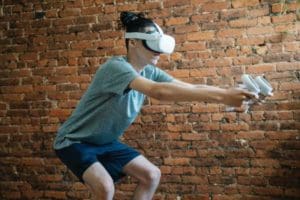Articulate
See What Your Course Might Look Like – 7 Practical Articulate Rise Examples
If you’re exploring elearning options for your organization, you’ve likely come across Articulate Rise 360—a...
Read MoreWhat is e-learning? Well, there are many types of e-learning that organizations can use to educate or train people. Understanding what is e-learning and the best types of e-learning to use, is critical when creating new training programs.
A physical institution no longer confines restrictions to learning. It took a pandemic for many governmental and educational institutes to understand this. But the corporate world had incorporated e-learning into their training and development programs well before the pandemic. After all, many corporate employees don’t have the time and flexibility to attend in-person training sessions. And the cost of organizing in-person sessions, the travel costs, and the lost productivity resulted in the corporations embracing e-learning before many others.
“72% of organizations claimed that e-learning gave them the competitive advantage they needed in 2017″ E-learning Industry.
So, let’s dive into what is e-learning and how different types of e-learning solve various problems for organizations.
The simplest way to define what is e-learning 
The term e-learning was used for the first time in 1999 by Elliot Maisie.
Since then, the advancement in technology has significantly improved the dissemination of learning through enhanced media options. Nowadays, wherever you are, if you have access to your digital device, you have access to e-learning.
It’s essential to understand some of the benefits that e-learning offers to appreciate the reasons behind its widespread adoption. And before learning about the types of e-learning available.
“E-learning motivators for employees are individual learning pace (95%) and no traveling (84%).” KPMG
Many more benefits of e-learning exist. As discussed in these articles: Pro’s and Con’s of Online Learning – Startling Lessons From Covid19 and Benefits of Online Learning: 27 of the Best Secrets You Need to Know Today
“Online courses will reduce energy consumption by up to 90% and produce 85% fewer CO2 emissions compared to face-to-face education.” Study conducted by Britain’s Open University.
To answer what is e-learning, we first need to discuss synchronous and asynchronous e-learning.
Above, we mention the term self-paced as being a benefit. What does that mean? This attribute implies that e-learning does not have to follow predefined schedules managed by third parties. Such as the case where people attend classes in a physical space at predefined times.
These types of classes at set times and locations are called synchronous learning. And so, the student must follow a preset pace and schedule.
On the opposite end of the spectrum is the ability to learn at your convenience – whenever you find the time. Known as asynchronous learning, where a student may learn at any time they deem fit and learns as much they want to at any sitting. This type of e-learning gives students flexibility.
Formally defined, synchronous learning is when group participants engage in learning simultaneously and are given room to engage. On the other hand, asynchronous learning does not require interpersonal engagement.
But, don’t assume e-learning cannot provide synchronous learning. Through the use of web conferencing and other learning environments, e-learning too can be synchronous. It’s a matter of what’s essential for the specific course you are designing and what will provide the best instructional content.
For example, many believe self-paced learning

Is This Synchronous Or Asynchronous?
is all that is needed. And it is suitable for structured types of e-learning. For example, software training or to increase product knowledge. But synchronous e-learning is beneficial to allow for unique questions and feedback from the instructor. For example, synchronous e-learning is excellent for an applied situation, such as practicing skills and case study discussions. As well it establishes trust and humanizes the learning experience.
Many organizations will utilize both these types of e-learning, and it’s the first step towards understanding what is e-learning.
“E-learning helps students retain five times more knowledge for every hour of learning.” E-Learning Industry
Among these types of e-learning, synchronous learning is an easily digestible concept, given that such a mode of learning has traditionally been followed. It allows for a sense of community, engagement, and collaboration. Simultaneously, it ensures that any questions are instantly resolved for the students. And makes the learning more concentrated and engaging.
Yet, there is no one universal way to use synchronous e-learning. In understanding what is e-learning, it is essential to know the types of e-learning options you have to choose from.
The following are considered the most popular types of e-learning used in synchronous learning designs.
Live podcasts are the modern adaptation of a radio show. Like a traditional podcast, the podcast is streamed through online software. The only difference, of course, is that the show is not pre-recorded. That is what helps live podcasts qualify as a type of synchronous e-learning channel.
Live podcasts may sometimes also include
Live virtual classrooms are the direct counterpart of physical classes where students gather in a physical space to learn. A live virtual classroom may take advantage of any of the numerous web conferencing software available. Of course, over the past year, there have been significant improvements to create a classroom atmosphere. Examples of virtual classroom technology include Zoom, WebEx, Adobe Connect, amongst others.
Typically, this type of e-learning will include an instructor preparing slides or educational material in advance to share with the class. And, the instructor may also choose to stream their video for portions of the virtual course.
Virtual Classrooms are often used for cohort-based learning, such as learning how to facilitate.
A webinar is most adequately defined as a web seminar.
Like any seminar, a webinar includes a panel of experts or a single expert that informs on a particular subject. Communication is therefore defined as one-to-many. By default, most of the talking comes from the expert(s) on the subject(s). This means that the interface for such communication restricts interference from the listeners.
Listeners then are allowed to unmute and ask questions when it’s time for discussion and questions.
Webinars are often a good tool for remote presentations and timely updates.
Learning through coaching can often form an essential part of learning, especially for role play and practice.
Such as for sales training. And coaching can also be transferred online to an asynchronous learning technique called virtual coaching.
The methodology will make use of web conferencing software similar to live virtual classrooms. But the number of participants will be significantly lower. Usually, coaching sessions only include 2 participants – a coach and a student.
“90% of corporations now use e-learning compared to just 4% in 1995.” KPMG
What type of e-learning is a flipped classroom? A flipped classroom is called that because it reverses the ideas of classwork and homework. In this teaching model, recorded lectures replace class time. Subsequently, students come to class to apply what they learned through the online lessons they reviewed at home.
This methodology is known to significantly increase the efficiency of teaching course content, as video lectures save time. With a set agenda, students then discuss and practice what was learned in the video lectures. When students meet in class, they get more time to cover practical applications of the theory they’ve already learned.
This learning methodology combines online and physical or virtual classroom learning. It creates a learning methodology where one component of the instruction complements the other.
The online learning portion may use interactive tools and online meetings to connect students. At the same time, this leaves physical classrooms for hands-on learning or discussion of complex topics. An example is management training such as interviewing candidates. Or how to give performance feedback. The theory would be provided online with examples. And then, the physical classroom instruction would allow time for instructor feedback and role-playing.
Asynchronous e-learning is the second of the two online teaching methodologies. Often it minimizes the time in the teaching process. Asynchronous types of e-learning are designed to be one-way communication. But, they are compelling in their ability to allow flexible learning for those that cannot commit to scheduled programs.
What is e-learning if you can’t learn on your terms? And, is it possible to add interactive elements to create an engaging experience.
You’ll find out below as the following are types of asynchronous e-learning methodologies are discussed.
Microlearning is one of the more modern types of e-learning. It relies on skill-based learning that focuses on specific niches, for example, software tips and tricks.
Rather than developing a theoretical background in the subject and complementing it with applications, microlearning takes place through asynchronous methods and in brief time bursts. For example, through short videos or animations. Such as in safety training to examine a specific incident or training procedure.
Such learning is naturally more focused on skills. It is highly relevant to corporate workers looking to complement their existing skills portfolio.
As the name suggests, a self-paced course is a pre-built course that can be found and studied at the student’s own pace.
At Spark + Co., we design many self-paced courses for our clients across many industry sectors. Including private and public companies, governmental agencies, and non-profits. Self-paced courses are ideal for onboarding new employees and broad topics such as privacy regulations or how to manage your mental health. An example of a self-paced course development project is (link to Cannabis our case studies)
“50% of K-12 teachers take professional online training classes.” Tomorrow
Email or text drip campaigns are not a new concept. A drip relies on sending a more significant chunk of information broken down into smaller, individual emails. These are sent at predefined intervals.
They are sometimes based on a set schedule (daily or weekly) or upon completing specific sections in the course.
Using this concept, learning courses can be delivered over email or text. And specific segments sent out over time. Given that long emails aren’t very appealing, you must break the content into bite-sized, relevant portions. Often, emails will direct the learner toward the resources and include embedded videos or other interactive features.
Recorded webinars are precisely what they sound like – online recorded seminars. For example, it could be an asynchronous webinar that you recorded for later use. This makes it easier to preserve the learning from an expert, especially if it is conducted from a difficult to replicate location or activity.
A recorded webinar does reduce the little engagement that a live webinar has. But, there are cost-effective ways to add interactive elements to the recorded webinar to make an instructional product. For example, on topics such as how to do an audit or write a business plan.
An interactive video is a more engaging approach to learning. In contrast to a regular video, an interactive video takes input from the viewer. Such a video may present different scenarios based on the viewer’s actions expressed through clicks, hovers, gestures, scrolls, or drags. It could also be in the form of a game or a case study.
Interactive videos are often used for analyzing safety situations, warehouse training, and restaurant training etc.
And they can be a powerful asynchronous e-learning tool due to the high engagement with the learner.
Simulations, too, are one of the types of e-learning most often used in digital gameplay and designed to create maximum engagement. Its use in learning is often with case study type learning. A simulation is an imitation of a real-world scenario expressed digitally. The use of simulations allows case studies to be brought to life and helps understand contextually relevant information. For example, flight simulators are a common use of simulations. Two other great examples of simulations are Livesaver from the UK and a social work course from Ryerson University.
The immersive experience of a simulation often makes for some of the most exciting learning methodologies in the world of asynchronous learning.
Fixed e-learning is perhaps the closest that asynchronous learning can come to traditional classrooms. The term “fixed e-learning” refers to the course content, and learning schedules are all fixed before commencement.
With fixed e-learning courses, there are few or even no changes made, even if the feedback suggests a need to change. Fixed e-learning is a rudimentary form of an asynchronous course. Yet, it can still be a valuable type of e-learning in certain instances. For example, academic institutions use massive open online courses (MOOCs).
Adaptive e-learning looks to solve the shortcomings of fixed e-learning. This form of asynchronous learning relies on using feedback from learners and incorporating that into the process. For example, feedback from quizzes and assessments can indicate where further instruction is required. And can update the learning curriculum as it progresses, such as learning a language using a tool like Duolingo.
Adaptive e-learning can change how education progresses around the globe. But this also means that planning and implementing requires significant expertise to design this type of e-learning.
Collaborative e-learning comes the closest to synchronous learning in terms of its ability to engage people. It focuses on learning as a group to achieve individual learning objectives.
Through this method, the group learns to practice the essentials of teamwork and synergy. It allows participants to learn essential communication skills and work on individual group weaknesses to strengthen the group as a whole. It makes collaborative e-learning a potent learning tool. For example, Miro is a tool that creates an electronic whiteboard to enable people in disparate locations to collaborate.
Game-based e-learning is an old concept but takes on new adaptations with e-learning.
The general idea behind this form of asynchronous e-learning is to add learning to games. It can be as simple as connecting dots to make shapes to extremely interactive digital protocols to teach skills.
Note that game-based e-learning should not be confused with gamification. Gamification is only about using game mechanics to make learning more enjoyable. In contrast, game-based e-learning is about using actual games to learn. An example of game-based e-learning is teaching people how to trade in the stock market by trading fake stocks.
What type of e-learning would virtual reality
The difference between virtual reality and interactive videos is how deeply immersive the environment can get. By default, virtual reality is highly engaging and drives more interest in learning. Examples of good uses for virtual reality include first responder training and medical surgeries.
Podcasts have long been viewed as educational content and learning material. And, their importance in the learning world is seen to be more than just curriculum-based. They are often used to introduce novel ideas. And the convenience for the listener is highly desirable. Allowing someone to listen to it while commuting or relaxing makes it a powerful tool for simple asynchronous e-learning. Now ‘pod-courses’ are the new trend. An example where recorded podcasts are used as types of e-learning includes inspirational stories and examples that the learner can apply in their situation. Or to learn behavioral skills such as how to improve personal productivity.
Flipped classrooms have already been defined as an asynchronous learning methodology.
However, the fact that the lectures themselves are asynchronous means that flipped classrooms can be termed an asynchronous e-learning technique.
Flipped classrooms revolve around using pre-recorded lectures as substitutes for classroom learning. Once the lectures are completed, the students visit a physical classroom to learn the application of the classroom learning.
Blended e-learning brings together in-class and virtual exercises to make the most of each of the two. It makes blended e-learning also a synchronous and asynchronous e-learning technique.
Such a technique creates flexible learning schedules for those with other commitments on their time, such as a full-time job.
A blended e-learning technique can also often be called a hybrid learning model and has become very relevant in a world ridden by a pandemic. Examples, where it is used include interpreting regulatory guidelines or learning computer coding.
As you can see from our discussion of what is e-learning, asynchronous and synchronous e-learning methodologies are not mutually exclusive. Often to make the most of the learning, the various types of e-learning discussed above are combined. Knowing the goals and requirements of the learner, along with the type of content, can allow for recommendations to be made about which types of e-learning methodologies should be used. Knowing the basics about what is e-learning and the various types of e-learning, provides you an understanding of the types of methods to use to train your learners.
Spark + Co has worked with over 60 clients since 2007 providing custom e-learning courses. And helping businesses, non-profits, and government agencies to achieve their training goals. If you need some expert help, get in touch with us now.